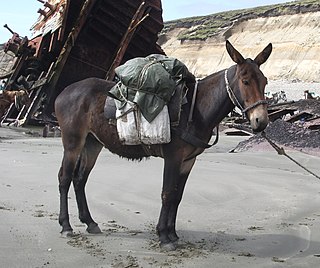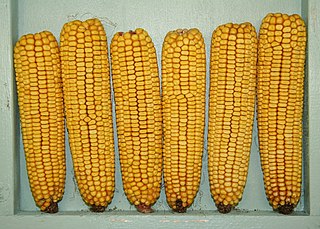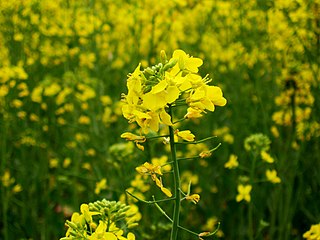
In biology, a hybrid is the offspring resulting from combining the qualities of two organisms of different varieties, subspecies, species or genera through sexual reproduction. Generally, it means that each cell has genetic material from two different organisms, whereas an individual where some cells are derived from a different organism is called a chimera. Hybrids are not always intermediates between their parents such as in blending inheritance, but can show hybrid vigor, sometimes growing larger or taller than either parent. The concept of a hybrid is interpreted differently in animal and plant breeding, where there is interest in the individual parentage. In genetics, attention is focused on the numbers of chromosomes. In taxonomy, a key question is how closely related the parent species are.
Heterosis, hybrid vigor, or outbreeding enhancement is the improved or increased function of any biological quality in a hybrid offspring. An offspring is heterotic if its traits are enhanced as a result of mixing the genetic contributions of its parents. The heterotic offspring often has traits that are more than the simple addition of the parents' traits, and can be explained by Mendelian or non-Mendelian inheritance. Typical heterotic/hybrid traits of interest in agriculture are higher yield, quicker maturity, stability, drought tolerance etc.

Yuan Longping was a Chinese agronomist and inventor. He was a member of the Chinese Academy of Engineering known for developing the first hybrid rice varieties in the 1970s, part of the Green Revolution in agriculture. For his contributions, Yuan is known as the "Father of Hybrid Rice".
F1 hybrid (also known as filial 1 hybrid) is the first filial generation of offspring of distinctly different parental types. F1 hybrids are used in genetics, and in selective breeding, where the term F1 crossbreed may be used. The term is sometimes written with a subscript, as F1 hybrid. Subsequent generations are called F2, F3, etc.

"Open pollination" and "open pollinated" refer to a variety of concepts in the context of the sexual reproduction of plants. Generally speaking, the term refers to plants pollinated naturally by birds, insects, wind, or human hands.
In agriculture and gardening, hybrid seed is produced by deliberately cross-pollinated plants which are genetically diverse. Hybrid seed is common in industrial agriculture and home gardening. It is one of the main contributors to the dramatic rise in agricultural output during the last half of the 20th century. Alternatives to hybridization include open pollination and clonal propagation.

Anemophily or wind pollination is a form of pollination whereby pollen is distributed by wind. Almost all gymnosperms are anemophilous, as are many plants in the order Poales, including grasses, sedges, and rushes. Other common anemophilous plants are oaks, pecans, pistachios, sweet chestnuts, alders and members of the family Juglandaceae. Approximately 12% of plants across the globe are pollinated by anemophily, including cereal crops like rice and corn and other prominent crop plants like wheat, rye, barley, and oats. In addition, many pines, spruces, and firs are wind-pollinated.

Hand pollination, also known as mechanical pollination is a technique that can be used to pollinate plants when natural or open pollination is either undesirable or insufficient.
A seedless fruit is a fruit developed to possess no mature seeds. Since eating seedless fruits is generally easier and more convenient, they are considered commercially valuable.
Cytoplasmic male sterility is total or partial male sterility in hermaphrodite organisms, as the result of specific nuclear and mitochondrial interactions. Male sterility is the failure to produce functional anthers, pollen, or male gametes. Such male sterility in hermaphrodite populations leads to gynodioecious populations.

Hybrid rice is a type of Asian rice that has been crossbred from two very different parent varieties. As with other types of hybrids, hybrid rice typically displays heterosis or "hybrid vigor", so when grown under the same conditions as comparable purebred rice varieties, it can produce up to 30% more yield. To produce hybrid seeds in large quantity, a purebred sterile rice variety is fertilized with fertile pollen from a different variety. High-yield crops, including hybrid rice, are one of the most important tools for combatting worldwide food crises.

The Connecticut Agricultural Experiment Station (CAES) is the Connecticut state government's agricultural experiment station, a state government component that engages in scientific research and public outreach in agriculture and related fields. It is the oldest state experiment station in the United States, having been founded in 1875. Its official mission is to "develop, advance, and disseminate scientific knowledge, improve agricultural productivity and environmental quality, protect plants, and enhance human health and well-being through research for the benefit of Connecticut residents and the nation." The station operates a main research campus in New Haven, a research farm in Hamden, a satellite research facility and farm in Windsor, and a research farm in Griswold. The Storrs Agricultural Experiment Station is a separate agricultural research agency, founded in 1887 and part of the University of Connecticut, which also receives state and federal funding.

Joseph Gottlieb Kölreuter, also spelled Koelreuter or Kohlreuter, was a German botanist who pioneered the study of plant fertilization, hybridization and was the first to detect self-incompatibility. He was an observer as well as a rigorous experimenter who used careful crossing experiments although he did not inquire into the nature of heritability.

Maize, also known as corn in North American English, is a tall stout grass that produces cereal grain. It was domesticated by indigenous peoples in southern Mexico about 9,000 years ago from wild teosinte. Native Americans planted it alongside beans and squashes in the Three Sisters polyculture. The leafy stalk of the plant gives rise to male inflorescences or tassels which produce pollen, and female inflorescences called ears. The ears yield grain, known as kernels or seeds. In modern commercial varieties, these are usually yellow or white; other varieties can be of many colors.

Dent corn, also known as grain corn, is a type of field corn with a high soft starch content. It received its name because of the small indentation, or "dent", at the crown of each kernel on a ripe ear of corn. Reid's Yellow Dent is a variety developed by central Illinois farmer James L. Reid. Reid and his father, Robert Reid, moved from Brown County, Ohio, to Tazewell County, Illinois, in 1846 bringing with them a red corn variety known as "Johnny Hopkins", and crossed it with varieties of flint corn and flour corn. Most of today's hybrid corn varieties and cultivars are derived from it. This variety won a prize at the 1893 World's Fair.

Plant breeding is the science of changing the traits of plants in order to produce desired characteristics. It has been used to improve the quality of nutrition in products for humans and animals. The goals of plant breeding are to produce crop varieties that boast unique and superior traits for a variety of applications. The most frequently addressed agricultural traits are those related to biotic and abiotic stress tolerance, grain or biomass yield, end-use quality characteristics such as taste or the concentrations of specific biological molecules and ease of processing.
Plant breeding started with sedentary agriculture, particularly the domestication of the first agricultural plants, a practice which is estimated to date back 9,000 to 11,000 years. Initially, early human farmers selected food plants with particular desirable characteristics and used these as a seed source for subsequent generations, resulting in an accumulation of characteristics over time. In time however, experiments began with deliberate hybridization, the science and understanding of which was greatly enhanced by the work of Gregor Mendel. Mendel's work ultimately led to the new science of genetics. Modern plant breeding is applied genetics, but its scientific basis is broader, covering molecular biology, cytology, systematics, physiology, pathology, entomology, chemistry, and statistics (biometrics). It has also developed its own technology. Plant breeding efforts are divided into a number of different historical landmarks.

Dhara Mustard Hybrid-11, otherwise known as DMH - 11, is a genetically modified hybrid variety of the mustard species Brassica juncea. It was developed by Professor Deepak Pental from the University of Delhi, with the aim of reducing India's demand for edible oil imports. DMH - 11 was created through transgenic technology, primarily involving the Bar, Barnase and Barstar gene system. The Barnase gene confers male sterility, while the Barstar gene restores DMH - 11's ability to produce fertile seeds. The insertion of the third gene Bar, enables DMH - 11 to produce phosphinothricin-N- acetyl-transferase, the enzyme responsible for Glufosinate resistance. This hybrid mustard variety has come under intense public scrutiny, mainly due to concerns regarding DMH - 11's potential to adversely affect the environment as well as consumer health. DMH - 11 was found not to pose any food allergy risks, and has demonstrated increased yields over existing mustard varieties. Conflicting details and results regarding the field trials and safety evaluations conducted on DMH - 11 have delayed its approval for commercial cropping.
Starmaya is an F1 hybrid coffee tree that can be propagated by seed rather than through somatic embryogenesis (SE). It was propagated from a parent plant that is male-sterile. This facilitates controlled pollination because breeders do not have to manually castrate each individual flower of the autogamous coffee tree.

Silphium integrifolium is a species of flowering plant in the family Asteraceae. Its common names include rosinweed, whole-leaf rosinweed, entire-leaf rosinweed, prairie rosinweed, and silflower. It is native to eastern North America, including Ontario in Canada and the eastern and central United States as far west as New Mexico.















